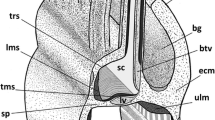Summary
Armandia brevis responds negatively to light during the benthic phase and positively to light during the epitokous phase of its life history. In addition to the prostomial photoreceptors this slender translucent marine worm possesses eleven pairs of ocelli arranged serially from the 7th to the 17th segments.
Each ocellus is located at the inner edge of the epidermis slightly in front of the parapodium and contains a single photoreceptor cell which gives off approximately 15 sensory processes. These processes are composed of a central core of neurofibrils surrounded by a mitochondrial layer and a compact array of microvilli. The sensory processes project into and nearly fill the ocellar cavity which is lined by squamous glial cells.
The pigment cup enclosing the photoreceptor is composed of about 30 cuboidal cells packed with brown granules. The pigment cells form a mesothelium, being in direct continuity with the coelom. The cup is separated from the glial cells by a basal lamina which separates the epidermal tissues from the mesodermal derivatives of the body wall. Slender muscle fibers traverse the coelom and pass between the cells of the pigment cup.
The prostomial photoreceptors were re-examined and found in this material to be composed of microvilli rather than of folds containing labyrinthine tubular infoldings of the cell surface as previously reported.
Similar content being viewed by others
References
Åkesson, B.: The comparative morphology and embryology of the head in scale worms (Aphroditidae, Polychaeta). Ark. Zool. 16, 125–163 (1963).
Dhainaut-Courtois, N.: Sur la présence d'un organe photorécepteur dans le cerveau de Nereis pelagica L. (Annélide polychète). C. R. Acad. Sci. (Paris) 261, 1085–1088 (1965).
—: Étude histologique et ultrastructurale des cellules nerveuses du ganglion cérébral de Nereis pelagica L. (Annélide Polychète). Comparaison entre les types cellulaires I–VI et ceux décrits antérieurement chez les Nereidae. Gen. comp. Endocr. 11, 414–443 (1968).
Eakin, R. M.: Lines of evolution of photoreceptors. In: General physiology of cell specialization. New York: McGraw-Hill Book Co. 1963.
—: Evolution of photoreceptors. In: Evolutionary biology, vol. 2. New York: Appleton-Century-Crofts 1968.
—, and J. A. Westfall: Further observations on the fine structure of some invertebrate eyes. Z. Zellforsch. 62, 310–332 (1964).
Fischer, A.: Über den Bau und die Heil-Dunkel-Adaptation der Augen des Polychäten Platynereis dumerilii. Z. Zellforsch. 61, 338–353 (1963).
—, u. J. Brökelmann: Das Auge von Platynereis dumerilii (Polychaeta). Sein Feinbau im ontogenetischen und adaptiven Wandel. Z. Zellforsch. 71, 217–244 (1966).
Hermans, C. O.: The reproductive and developmental biology of the opheliid polychaete, Armandia brevis (Moore). M. S. Thesis, Univ. of Wash., Seattle, 1964, 131 p.
—, and R. A. Cloney: Fine structure of the prostomial eyes of Armandia brevis (Polychaeta: Opheliidae). Z. Zellforsch. 72, 583–596 (1966).
Hesse, R.: Untersuchungen über die Organe der Lichtempfindung bei niederen Thieren. V. Die Augen der polychaeten Anneliden. Z. wiss. Zool. 65, 446–516 (1899).
Jägersten, G.: Studies on the morphology, larval development and biology of Protodrilus. Zool. Bidr. Uppsala 29, 426–511 (1952).
Kernéis, A.: Nouvelles données histochimiques et ultrastructurales sur les photorécepteurs ≪branchiaux≫ de Dasychone bombyx (Dalyell) (Annélide Polychète). Z. Zellforsch. 86, 280–292 (1968).
— Ultrastructure de photorécepteurs de Dasychone (Annélides Polychètes Sabellidae). J. Microscopie 7, 40a (1968).
Krasne, F. B., and P. A. Lawrence: Structure of the photoreceptors in the compound eyespots of Branchiomma vesiculosum. J. Cell Sci. 1, 239–248 (1966).
Kuwabara, T., and R. A. Gorn: Retinal damage by visible light. Arch. Ophthal. 79, 69–78 (1968).
Manaranche, R.: Sur la présence de cellules d'allure photoréceptrice dans le ganglion cérébroide de Glycera convoluta (Annélide Polychète). J. Microscopie 7, 44a (1968).
Merker, G., u. M. Vaupel-Von Harnack: Zur Feinstruktur des „Gehirns“ und der Sinnesorgane von Protodrilus rubropharyngaeus[sic] Jaegersten (Archiannelida). Mit besonderer Berücksichtigung der neurosekretorischen Zellen. Z. Zellforsch. 81, 221–239 (1967).
Röhlich, P., and E. Tar: The effect of prolonged light-deprivation on the fine structure of planarian photoreceptors. Z. Zellforsch. 90, 507–518 (1968).
Wilson, D. P.: The development of the sabellid Branchiomma vesiculosum. Quart. J. micr. Sci. 78, 543–603 (1936).
Wilson, E. B.: The cell-lineage of Nereis. J. Morph. 6, 361–480 (1892).
Author information
Authors and Affiliations
Additional information
The author thanks Dr. Richard M. Eakin for support and criticism. This investigation was financed by a postdoctoral fellowship, number 1-F2-GM-20, and grant number GM 10292 from the National Institute of General Medical Science.
Rights and permissions
About this article
Cite this article
Hermans, C.O. Fine structure of the segmental ocelli of Armandia brevis (Polychaeta: Opheliidae). Z. Zellforsch. 96, 361–371 (1969). https://doi.org/10.1007/BF00335214
Received:
Issue Date:
DOI: https://doi.org/10.1007/BF00335214




